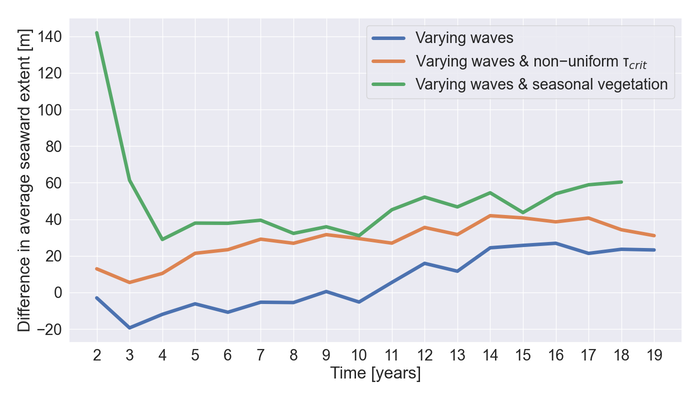S. Dzimballa1*, P.W.J.M. Willemsen1,2, V. Kitsikoudis1, B.W. Borsje1, D.C.M. Augustijn1
1 University of Twente, Netherlands; 2 Deltares, Netherlands
* Corresponding author: s.dzimballa@utwente.nl
Introduction
Salt marshes are important ecosystems in a world affected by climate change, as they provide numerous ecosystem services such as carbon sequestration (Barbier et al., 2011). They can also contribute to flood protection (Vuik et al., 2016). However, the complex spatiotemporal dynamics of salt marshes need to be understood to take their wave attenuation function into account when designing flood defences. Previous studies have shown that salt marshes' lateral extent is directly related to their wave attenuation potential, which varies spatiotemporally due to lateral retreat and expansion (Willemsen et al., 2020). Numerical models have been used to predict salt marsh evolution. These models are often limited in the processes considered depending on the aim of the study (Brückner et al., 2019; Mariotti, 2020). However, to capture and disentangle the complex biogeomorphological interactions, it is important to consider further processes within salt marsh evolution occurring at different temporal and spatial scales, such as seasonal vegetation dynamics, the effect of the root system on soil erodibility, multiple vegetation species and interspecies interactions. Thus, incorporating these processes in salt marsh models and accessing their individual effects on marsh development can provide important insights for predicting salt marsh development and lateral extent using numerical modelling.
Objective and Methods
This study aims to identify the importance of including shorter-term dynamics in numerical models to simulate long-term salt marsh development. By studying the biogeomorphological evolution of salt marshes over 50 years, we investigate the interplay of processes operating on different time scales. Marsh development is simulated using a coupled numerical model that integrates Delft3D Flexible Mesh for flow, morphology, and wave simulation with a dynamic vegetation module for an idealised domain. The established vegetation model simulates vegetation establishment, growth, and decay (Willemsen et al., 2022). The vegetation model is extended with seasonal vegetation dynamics, the presence of multiple species and inter-species interactions, and the effect of the root system on erosion by a spatiotemporally variable critical bed shear stress. External forcing from tides and constant and time-varying waves are considered. Furthermore, marsh-related modelling parameters (e.g. drag coefficient of vegetation) are varied to assess that influence compared to including more detailed salt marsh mechanisms.
Results
The study highlights the influence of different processes on lateral marsh extent. Seasonal variations influence longer-term marsh development, with seasonally lower wave forcing during the summer months leading to increased seaward establishment of vegetation. In addition, including non-uniform critical bed shear stress for erosion stabilises the seaward marsh extent and increases the overall mean vegetation density. were site-specific, depending on factors such as elevation and tidal range. It is, therefore, crucial to identify relevant site-specific processes to determine data requirements for predicting salt marsh development. These findings contribute to establishing confidence in numerical model predictions of salt marsh evolution, providing the basis for assessing marsh resilience and informing flood protection strategies.

Figure 1: Differences in average seaward salt marsh extent for different scenarios compared to the 'Constant waves' scenario over the simulation time.
References
Barbier, E. B., Hacker, S. D., Kennedy, C., Koch, E. W., Stier, A. C., & Silliman, B. R. (2011). The value of estuarine and coastal ecosystem services. In Ecological Monographs, 81(2), 169–193. https://doi.org/10.1890/10-1510.1
Brückner, M. Z. M., Schwarz, C., van Dijk, W. M., van Oorschot, M., Douma, H., & Kleinhans, M. G. (2019). Salt Marsh Establishment and Eco-Engineering Effects in Dynamic Estuaries Determined by Species Growth and Mortality. Journal of Geophysical Research: Earth Surface, 124(12), 2962–2986. https://doi.org/10.1029/2019JF005092
Mariotti, G. (2020). Beyond marsh drowning: The many faces of marsh loss (and gain). Advances in Water Resources, 144. https://doi.org/10.1016/j.advwatres.2020.103710
Vuik, V., Jonkman, S. N., Borsje, B. W., & Suzuki, T. (2016). Nature-based flood protection: The efficiency of vegetated foreshores for reducing wave loads on coastal dikes. Coastal Engineering, 116, 42–56. https://doi.org/10.1016/j.coastaleng.2016.06.001
Willemsen, P. W. J. M., Borsje, B. W., Vuik, V., Bouma, T. J., & Hulscher, S. J. M. H. (2020). Field-based decadal wave attenuating capacity of combined tidal flats and salt marshes. Coastal Engineering, 156(January), 103628. https://doi.org/10.1016/j.coastaleng.2019.103628
Willemsen, P. W. J. M., Smits, B. P., Borsje, B. W., Herman, P. M. J., Dijkstra, J. T., Bouma, T. J., & Hulscher, S. J. M. H. (2022). Modeling Decadal Salt Marsh Development: Variability of the Salt Marsh Edge Under Influence of Waves and Sediment Availability. Water Resources Research, 58(1), 1–23. https://doi.org/10.1029/2020WR028962


